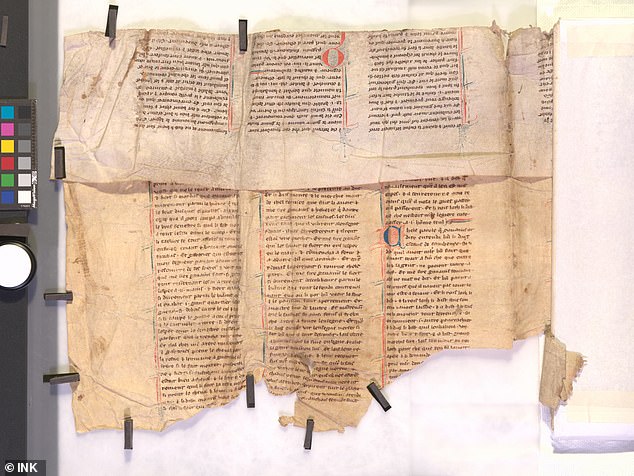
Long-Lost King Arthur and Merlin Manuscript Resurfaces After 700 Years Hidden in Another Book
Lost Medieval Tales of King Arthur and Merlin Discovered Hidden in 16th-Century Book
Scientists at the University of Cambridge have uncovered a 700-year-old manuscript containing forgotten stories of King Arthur and Merlin, hidden inside a 16th-century property record. Using cutting-edge technology, researchers digitally “unrolled” the fragile parchment without causing damage, revealing an “extremely significant” Arthurian text written in Old French between 1275 and 1315.
[Image: A medieval manuscript with Old French text, captioned: The manuscript, written in Old French, survived centuries after being repurposed as a book cover.]
The manuscript contains two episodes from Suite Vulgate du Merlin, a French sequel to the Arthurian legends. Fewer than 40 copies of this text exist today. Written on durable sheepskin parchment, it was later recycled as a binding for a land deed from Huntingfield Manor in Suffolk. “This reuse tells us about 16th-century archival practices—it’s history within history,” said Dr. Irène Fabry-Tehranchi, a Cambridge medievalist.
The Hidden Stories
The first episode recounts a battle led by Sir Gawain, Arthur’s nephew and a famed knight, against Saxon invaders. Gawain wields Excalibur, Arthur’s legendary sword, which he later returns for the king’s final clash with his traitorous son, Mordred. The second story describes Merlin’s dramatic arrival at Arthur’s court during a feast. Disguised as a harpist in a jeweled silk tunic, Merlin dazzles attendees before transforming into a child to deliver a prophecy.
[Image: Artistic depiction of Merlin in a medieval court, captioned: Merlin’s magical entrance at King Arthur’s feast, as described in the rediscovered text.]
A Technological Breakthrough
The manuscript’s poor condition—folded, torn, and stitched into a book—made physical unrolling impossible. Researchers used X-rays, multispectral imaging, and 3D modeling to virtually reconstruct the text. Mirrors, prisms, and magnets revealed sections hidden under folds or stitching. The result is an interactive 3D model, allowing the public to explore the manuscript online via the Cambridge Digital Library.
[Image: Researchers using a micro-CT scanner on the manuscript, captioned: Advanced imaging techniques revealed text invisible to the naked eye.]
Errors and Mysteries
The manuscript includes scribal errors, such as a misspelled warrior’s name (“Dorilas” instead of “Dodalis”), highlighting its handmade nature. These quirks offer insights into medieval storytelling and the scribe’s process.
Legacy and Access
The project not only revives lost Arthurian lore but also pioneers methods for studying fragile manuscripts. “This isn’t just about one text—it’s a model for accessing hidden histories globally,” said Dr. Fabry-Tehranchi. The team’s findings were presented at the Cambridge Festival, inspiring new interest in medieval fragments repurposed in bookbindings.
[Image: Digital reconstruction of the manuscript, captioned: The 3D model lets users virtually “handle” the manuscript, zooming in on details.]
Explore Online
The manuscript’s digital version is freely accessible, offering a glimpse into a world where magic and history intertwine. As researchers continue to decode hidden texts, this discovery reminds us that even the most ordinary objects might guard extraordinary secrets.
[Image: Close-up of the manuscript’s intricate script, captioned: Annotations from the 16th century, including “Huntingfield,” visible through imaging.]
For more details, visit the Cambridge Digital Library.
Word count: ~600
Images suggested: 5 (as marked, with simplified captions).


